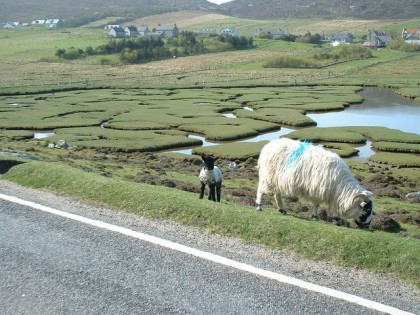
The local/organic/good food movement has brought some traditional ways of raising livestock to prominence once again. For example – pigs that forage in the woods for acorns to produce Jamón ibérico; cattle that graze on only grass for more nutritious and tasty beef; and sheep that eat salt marsh grass, which is “far from tasting salty but is light and sweet.”
Salt marsh lamb is a delicacy in Europe, where it is raised in the coastal marshes of France and the U.K. The sheep graze on salt marsh plants such as Spartina, Sea Lavender, and Samphire. Salt marsh sheep are a reminder of the bygone tradition of livestock grazing on salt marshes in North America.
From the mid-Atlantic north through the maritime provinces of Canada, cattle once dined on the same salt marsh plants as European lambs. Like many artisanal approaches, the technique was borne of necessity and geography rather than any high-minded pursuit of exquisite flavor.
On our colonial coastlines, one of the very first activities that settlers engaged in was “meadow banking.” Drawn from traditions and techniques of coastal Europe, this practice entailed hand-building dyked impoundments and water control structures in tidal wetlands to hold back the tide and make the wetlands accessible for farming and livestock.
Farmers harnessed the incredible productivity of salt marshes to make their living, with “one acre of salt marsh held equal to ten of woodland or two of pasture or cornland.” Because such coastal engineering required considerable cooperation, many communities and local governments have their roots in these cooperative “meadow banking companies.”
A few dyked salt marshes still exist in South Jersey. Here’s a photo of a muddy dyke holding back the tide with farmed salt hay behind it.
One farm that rose from these colonial origins to regional prominence during the 20th century was Abbott’s Dairy. The Abbott family settled near Salem, New Jersey in the mid-1800’s and took over several meadow banking cooperatives to form the Abbot meadow company.
On these “reclaimed” marshes the Abbotts raised Alderney dairy cattle, a breed from the channel islands of England. The Abbotts became innovators in preserving and shipping milk throughout the region as rail transport became available. By the 20th century Abbott’s milk was one of the most well-known brands in the mid-Atlantic, with its base of operations moved from the NJ salt marshes to Philadelphia.
The practice of farming the salt marshes has now all but disappeared in New Jersey. The networks of dykes and water control structures needed constant maintenance and as economic conditions shifted in the 20th century, maintenance lapsed and the tide has now reclaimed most of them. A few farms still exist and farm salt hay (Spartina patens) which has been used for cattle fodder, rope making, mulch, and pillow stuffing. These days it primarily sold as a weed-free mulch.
The story is quite different in the Bay of Fundy on the coasts of Nova Scotia and New Brunswick. The dykes there are now maintained by the provincial governments and livestock grazing and salt hay production in these salt marshes is still thriving.
For more on the farming of salt marshes, there is an excellent history of these practices available online via the National Park Service: From Marsh to Farm: The Landscape Transformation of Coastal New Jersey
P.S. All of these historic alterations to salt marshes have not been without ecological consequences. In particular, these past practices have implications for salt marsh resilience to increasing sea level rise. In a future post I’ll address some of these issues.